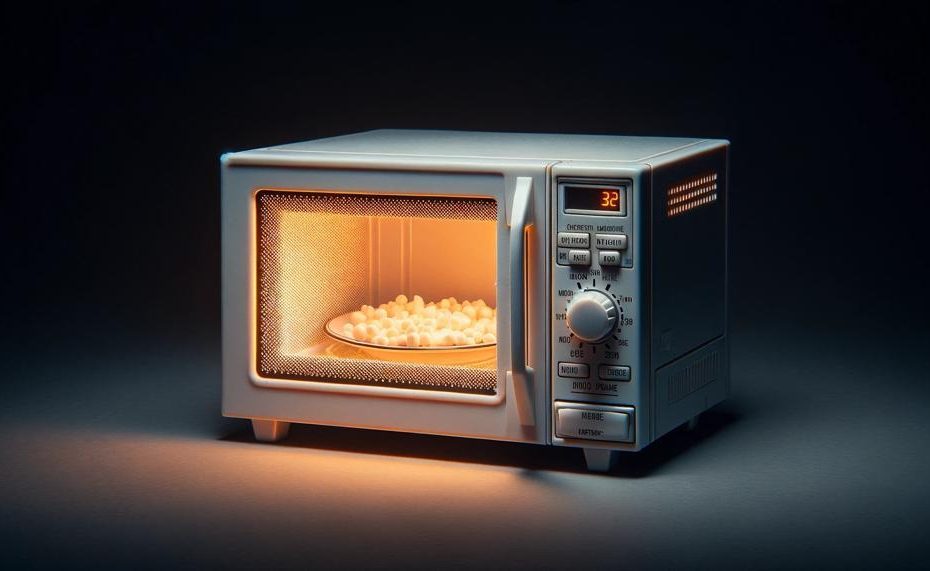Are you a busy bee who relies on their trusty microwave for quick and easy meals? Do you ever find yourself using it without its light and wondering if it’s really safe? Well, rest assured, you’re not the only one with these concerns. The safety of using a microwave without its light has been a hot topic (pun intended) among many users.
So, is it safe to use microwave without light?
Yes, using a microwave without a light is safe. You can only use the light to see your food while it cooks in the microwave. The cooking process is unaffected by the light and it does not provide electricity. Replaceable light bulbs are available if they go out. Under the bulb cover, below the vent grille at the top front of the microwave oven, is where you’ll find the cavity light bulb.
Checking your power source is a better idea if your microwave light suddenly goes out than seeing whether the bulb has blown. It could be time for a new microwave if the problem isn’t with your power supply. Some advise having the lightbulb changed by a certified service provider.
So grab your favorite snack (mine’s definitely popcorn) and let’s explore this topic together.
Contents
- 1 Is it Safe to Use a Microwave Without Light?
- 2 Is it Safe to Use During a Thunderstorm?
- 3 Can You Use a Microwave With Rust Inside?
- 4 Can You Use a Microwave Without a Turntable?
- 5 Can You Use a Microwave Without a Waveguide Cover?
- 6 Can You Microwave Aluminum Foil or Other Metal?
- 7 Microwave Radiation Safety Tips
- 8 What to do if Your Microwave has Safety Problems?
- 8.1 Inspect for any visible damage or malfunction
- 8.2 Refer to the user manual for specific safety guidelines
- 8.3 Use only containers that are safe for microwaves
- 8.4 Avoid putting metal objects in the microwave
- 8.5 Stay close to the microwave during longer cooking times
- 8.6 Regularly clean your microwave
- 9 Conclusion
Is it Safe to Use a Microwave Without Light?
Absolutely. The light bulb in a microwave has no direct impact on its safety or functionality. Its main purpose is to heat food and drinks, and this mechanism remains unaffected even if the light goes out. In fact, microwaves are much safer than the harmful ultraviolet light that hits your skin on a sunny day.
While using a microwave without a working light may be slightly less convenient, as the interior won’t be illuminated, it does not compromise its safety or performance. It is recommended to have an authorized service agent replace the light bulb, but this is not necessary for the microwave to function properly.
If you prefer having a working light in your microwave, you can easily replace the bulb at any time. However, if you are concerned about the performance of your microwave after the light goes out, you can test it by heating food and checking if it heats up as expected.
In conclusion, using a microwave without a functioning light poses no threat and will not affect its performance. The light bulb in a microwave serves solely for illumination purposes and has no direct correlation to how the microwave operates.
Is it Safe to Use During a Thunderstorm?
No, it is not safe to operate a microwave without its light during a thunderstorm. The risk of a power surge is significantly higher during a thunderstorm, which can potentially damage the microwave or even cause a fire.
Additionally, using a microwave during this weather condition can also put you at risk of electric shock.
Therefore, it is highly recommended to refrain from using any electronic appliances, including microwaves, during a thunderstorm.
| Hazards | Explanation | Safety Measures |
| Power Surge | A lightning strike can cause a power surge that may damage the microwave or lead to a fire. | Unplug all appliances and stay away from them until the storm has passed. |
| Electric Shock | Using electronic appliances during a thunderstorm puts you at risk of electric shock. | Avoid using any electronic appliances during a thunderstorm. |
| Fire Risk | A power surge or malfunction due to lightning strike can result in a fire in the microwave. | Unplug all appliances and stay away from them until the storm has passed. |
Even though the light bulb in a microwave may not seem like an essential feature, it serves an important purpose in terms of safety. The light allows you to monitor your food while it is being heated, preventing potential accidents such as spills or overheating. Without the light, it may be more challenging to keep an eye on the food being heated, increasing the risk of accidents.
Moreover, it is not just the microwave itself that poses a danger during a thunderstorm. The entire kitchen area can be hazardous in this weather condition. Water and electricity do not mix well, and the metal components in microwaves can conduct electricity, making them a potential hazard during a storm.
It is crucial to stay away from all electronic equipment, including corded phones, and avoid any contact with water or concrete structures.
Can You Use a Microwave With Rust Inside?
No, it is not safe to utilize a microwave with rust inside. Rust can pose significant health and safety risks, including rust arcing and radiation leakage.
Rust arcing occurs when the microwave rays reflect off the metal inside, causing sparks and potentially damaging the oven. This can also result in uneven heating of food and even spark a fire.
Radiation leakage from rust can have severe consequences on human health, such as glaucoma, sterility, and leukemia. It is crucial to regularly check for rust in your microwave and address it immediately to prevent any potential harm.
To test for radiation leaks, you can use a bulb or diagnostic tool specifically designed for this purpose. Another method is to ping the microwave with WiFi-enabled devices – any leaks will cause disruptions in the WiFi signal.
If you do discover rust inside your microwave, it is vital to deal with it as soon as possible. Microwaves have a unique type of paint that can withstand their environment. However, if there are pinholes in the rusty areas, the oven cannot be repaired and must be replaced.
To remove rust, the paint must be stripped and reapplied in thin layers after cleaning the interior with rubbing alcohol. Preventing rust in the future involves regularly cleaning the microwave with hot water and lemon slices for tough stains.
Can You Use a Microwave Without a Turntable?
It is indeed feasible to utilize a microwave without a turntable, however, there are both possible drawbacks and advantages to take into account.
Drawbacks:
- Uneven heating: Without a turntable, the distribution of microwaves may not reach all parts of the food equally, resulting in certain areas being overcooked while others remain undercooked.
- Manual rotation or stirring: To ensure uniform heating, you may need to manually rotate or stir your food during the cooking process, which can be cumbersome and time-consuming.
- Potential for spills: The absence of a turntable to secure the dish in place increases the likelihood of spills and messes in the microwave.
- Damage to microwave: Using a microwave without a turntable may cause wear and tear on the rotating mechanism, potentially leading to damage over time.
Advantages:
- Larger capacity: Microwaves without turntables often have more spacious interiors, allowing for larger dishes to be accommodated for cooking.
- Versatility: Without a turntable restricting the shape and size of dishes, you can utilize a wider range of cookware in the microwave.
- Easy to clean: With no turntable to remove and clean separately, it can be more effortless and convenient to clean the interior of the microwave.
- More even browning: In some cases, using a microwave without a turntable can result in more uniform browning of food due to the lack of rotation.
Can You Use a Microwave Without a Waveguide Cover?
No, it is not advisable to use a microwave without a waveguide cover. The waveguide cover plays a crucial role in protecting the oven cavity and control panel from any potential harm. Without it, microwaves can escape and cause damage to the oven and pose a safety risk to the user.
Why is the waveguide cover necessary?
The waveguide cover is necessary for directing and containing the microwaves, ensuring even heating and preventing any potential harm to the user.
Additionally, it acts as a barrier against food or liquid spills that can damage the oven cavity and control panel.
What happens if you use a microwave without a waveguide cover?
Using a microwave without a waveguide cover can result in serious damage to the oven and may even cause a fire.
The escaped microwaves can create sparks, leading to further complications and higher costs for repairs.
Can you replace a damaged waveguide cover?
Yes, you can easily replace a damaged waveguide cover. It is recommended to either do it yourself or seek professional assistance for proper installation. Neglecting to replace a damaged waveguide cover can lead to further complications and higher costs for repairing the microwave.
How much does it cost to replace a waveguide cover?
The cost of replacing a waveguide cover is relatively low, but may vary depending on location and installation fees.
It is important to regularly check the condition of the waveguide cover and promptly replace it if damaged to avoid any potential damage or safety hazards.
Can You Microwave Aluminum Foil or Other Metal?
When it comes to using aluminum foil or other metal in a microwave, it’s important to exercise caution and use proper techniques to avoid any potential harm or damage. As mentioned previously, a waveguide cover is essential for safe microwave use as it directs and contains the microwaves.
Without this cover, using aluminum foil or other metal can lead to serious consequences and safety hazards.
However, with the appropriate precautions, it is possible to safely use aluminum foil or other metal in a microwave. Here are some guidelines to keep in mind:
- Check your microwave: Before using aluminum foil or other metal in the microwave, make sure to check if your microwave has a metal turntable or shelving. If it does, avoid using aluminum foil as it can result in sparks and damage.
- Only cover a small portion of your food: When using aluminum foil or other metal in a microwave, only cover a small portion of your food. This reduces the risk of fire and ensures that your food is evenly heated.
- Avoid complete coverage: It is crucial to not fully cover your food with aluminum foil as it reflects radio waves and hinders proper heating. This can also cause uneven cooking and potentially start a fire.
- Monitor your food closely: While using aluminum foil or other metal in a microwave, it is important to keep a close eye on your food. If you notice any sparks or smoke, immediately stop the microwave and remove the foil.
Microwave Radiation Safety Tips

To maintain a safe and efficient use of your microwave, follow these simple steps:
Keep it Clean
Consistently clean both the inside and outside of your microwave to prevent any potential dangers or malfunctions.
Replace the Lightbulb If Desired
While it is entirely safe to operate a microwave without a light, some may prefer having a functional light for convenience. If desired, acquire a compatible lightbulb and replace it as needed.
Test the Microwave After the Light Goes Out
In the event that the light in your microwave goes out, it is recommended to test its functionality by heating up food before replacing the bulb. This will ensure that there are no interruptions in the electrical circuit.
Do Not Attempt to Fix Electrical Issues Yourself
If you notice any electrical issues or malfunctions with your microwave, do not attempt to fix them on your own. Contact a professional for assistance.
Ensure Proper Ventilation
Proper ventilation is crucial to avoid overheating or fire hazards when using your microwave.
Follow Manufacturer’s Instructions
Always adhere to the manufacturer’s instructions for safe and proper usage of your specific microwave model.
What to do if Your Microwave has Safety Problems?
For the safety of your microwave when facing light-related issues, follow these steps:
Inspect for any visible damage or malfunction
Look for any visible damage or malfunction in your microwave, such as a burnt-out light bulb or a damaged electrical circuit. If you notice any damage, do not use the microwave and seek professional assistance.
Refer to the user manual for specific safety guidelines
Each microwave model may have unique features and safety precautions that you should be aware of. Check the user manual to familiarize yourself with these guidelines, which can help prevent potential safety hazards.
Use only containers that are safe for microwaves
To avoid harmful chemicals from seeping into your food, use only containers that are safe for microwaves, such as glass, ceramic, or designated plastics.
Avoid putting metal objects in the microwave
Metal objects can cause sparks and potential fire hazards when placed inside a microwave. Do not use metal utensils, dishes, or aluminum foil when heating food in the microwave.
Stay close to the microwave during longer cooking times
It is always wise to stay near the microwave during longer cooking times in case of unexpected occurrences like overflowing food or burning smells. This way, you can quickly address any potential safety hazards.
Regularly clean your microwave
Leftover food particles can affect the efficiency of your microwave and become a fire hazard if not cleaned regularly. Use mild detergent and water to clean your microwave regularly and prevent these issues.
Remember, it is safe to use a microwave without its light functioning properly. However, if you prefer having a working light in your microwave, you can easily replace the bulb at any time.
Conclusion
In conclusion, disregarding the importance of the microwave’s light may seem minor, but it can have significant consequences. Without proper lighting, it becomes challenging to monitor your food and prevent potential hazards such as overcooking or burning.
This can lead to unpleasant smells and even fire risks. Moreover, removing hot items from the microwave without adequate visibility can result in accidental burns or spills, making it crucial to have a functional light.
Furthermore, using a microwave without its light during a thunderstorm is not only unsafe due to the risk of power surges and electric shock but also increases the chances of fire hazards. It is best to avoid using any electronic appliances during this weather condition.
Other safety concerns regarding microwaves include rust buildup inside the appliance, using it without a turntable or waveguide cover, and placing metal objects inside. Regular maintenance and cleaning can help prevent these issues and ensure safe usage.
Always remember to follow the manufacturer’s instructions and use only containers that are safe for microwaves. If you notice any visible damage or malfunctions with your microwave, seek professional assistance instead of attempting to fix it yourself.
In short, although using a microwave without its light may not immediately affect its functionality or safety, addressing this issue promptly is essential for optimal usage and peace of mind.





